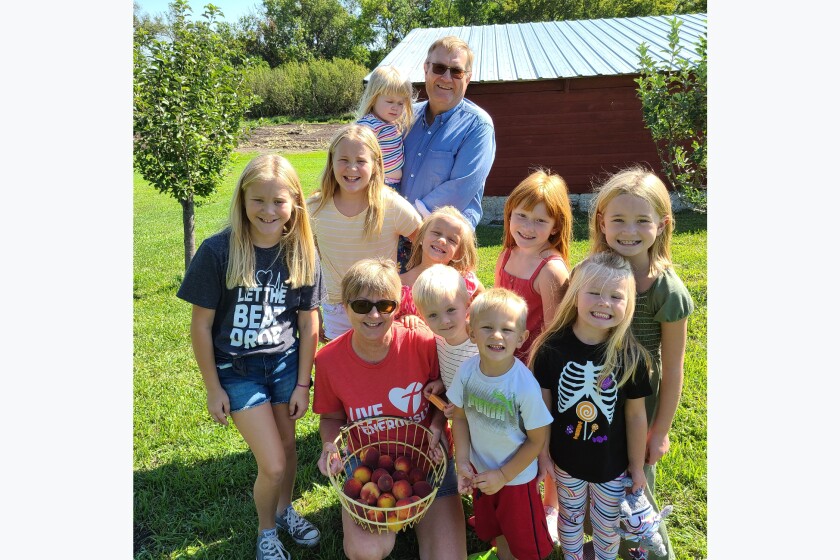Q: We live north of Veblen, S.D., 1 mile from the North Dakota-South Dakota border. We planted two Contender peach trees two years ago. In early September we picked two dozen peaches and they were the best we've ever eaten! — Janelle and Dave Vig.
A: Thanks, Janelle and Dave for proving that peaches can indeed be grown in the Dakotas. Janelle and Dave say, “The two Contender peach trees were planted in the spring of 2019 and this is the first year they bore fruit. We haven’t done anything to the trees in the winter except wrap them to prevent deer and bunny damage.”
ADVERTISEMENT
When we think peaches, we think Georgia, California or maybe Colorado, but definitely not North or South Dakota. Peaches are certainly marginal in winter-hardiness for the Upper Midwest, but the cultivars Contender, Reliance and Intrepid were developed with better hardiness than cultivars grown in milder climates.
The three types mentioned, although having better chances than other peach cultivars, are still very borderline in winter adaptability. To increase chances of success, plant in a microclimate created by an established yard having wind protection and ample insulating snow. Wrap the trunks in the winter, not only to protect from deer and rabbits, but also to prevent the damaging effects of winter trunk sunscald.
The basket of peaches looks mouthwatering. Your success reminds me of how my great-uncle wanted to prove peaches could be grown on his farm in southeastern North Dakota, which he accomplished by surrounding the peach tree top to bottom with an igloo of straw bales every winter.

RELATED COLUMNS:
-
This is the beautiful flower you might have seen more of around town
-
Early snow can affect lawns and landscapes
Q: We have some potentilla bushes that have broken in the past from heavy snow cover. Do you have any suggestions for something we can build or put over them to prevent the snow damage? — Maureen G.
ADVERTISEMENT
A: Potentillas, with their sunny yellow flowers, are among the toughest of landscape shrubs, thriving in heat, poor soil and adversity. Their branches aren’t overly sturdy, though, being somewhat brittle and less strong-wooded than some shrub types.
There are many potentilla cultivars, and they do vary in branch strength. My favorite is Dakota Sunspot, developed by North Dakota State University. Not only are the flowers large, brightly colored and cover the shrub from early summer through autumn, but I’ve never experienced branch breakage under snow.
To support potentillas with a history of snow breakage, circling the shrub with twine and drawing it tight, binding the branches closer together, might provide enough strength. Wire tomato cages, peony cages or circles of wire hardware cloth are options, if they can be situated tightly enough to lend support. Readers might share additional methods they’ve found successful.
On the upside, potentillas are best pruned radically every two or three years, removing at least one-third of the top growth. I prefer cutting them back to about 3 inches above ground level in early spring every other year. They bloom more profusely on fresh, juvenile growth. Even if potentillas are damaged by snow breakage, they respond well to the heavy pruning necessitated by the damage.
RELATED COLUMNS:
Q: After reading last week’s column discussing whether ornamental sweet potato vines produce tubers that are edible, I wanted to let you know the sweet potatoes from the ornamental ones are the best I have ever eaten. I didn’t age the tubers, but ate soon after digging. — Virginia B.
A: Thanks, Virginia, for the testimonial. Ornamental sweet potato vines are a common foliage accent used in pots and planters combined with flowering plants.
ADVERTISEMENT
When it’s time for fall cleanup, most of us find good-sized sweet potatoes growing beneath the ornamental vines. Most sources say the sweet potatoes are edible, but not palatable. I’m happy to get a firsthand account from a gardener who has actually eaten them!
If you have a gardening or lawn care question, email Don Kinzler, NDSU Extension-Cass County, at donald.kinzler@ndsu.edu. Questions with broad appeal may be published, so please include your name, city and state for appropriate advice.











